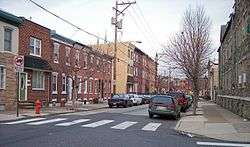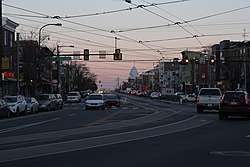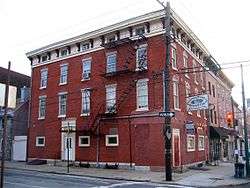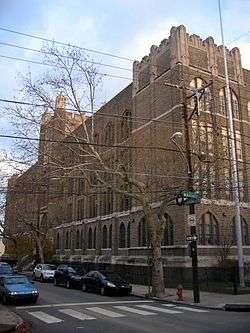Fishtown, Philadelphia
Fishtown is a neighborhood in Philadelphia, Pennsylvania, United States.[1] Located immediately northeast of Center City, its borders are somewhat disputed today due to many factors, but are roughly defined by the triangle created by the Delaware River, Frankford Avenue, and York Street. Some newer residents expand the area to Lehigh Avenue, while some older residents shrink the area to Norris Street. It is served by the Market–Frankford Line rapid transit subway/elevated line of the SEPTA system. Fishtown is known as a working class Irish Catholic neighborhood. Recently, however, the neighborhood has seen a large influx of young urban professionals and gentrification.[2]
Fishtown | |
|---|---|
Penn Treaty Park in Fishtown | |
 Fishtown | |
| Coordinates: | |
| Country | |
| State | Pennsylvania |
| County | Philadelphia County |
| City | Philadelphia |
| Area code(s) | 215, 267 and 445 |
The name Fishtown derives from one of the original occupation of its residents. Early settlers were fishermen and over time they controlled the fishing rights to both sides of the Delaware River from Cape May to the falls at Trenton, NJ. The apocryphal local legend traces the name of Fishtown to Charles Dickens, who purportedly visited the neighborhood in March 1842, but records show this to be false, as it was named Fishtown prior to his visit, at least as early as 1808 as evidenced in a newspaper article in "The Tickler" an early 19th Century Philadelphia newspaper.
History
The area was originally inhabited by members of the Turtle Clan of the Lenape Indian tribe (whom the Europeans named the Delaware Indian Tribe). The first European settlers were a group of six Swedish farming families, later replaced by British landed gentry, then British shipbuilders and German fishermen. Fishtown was originally a small section of the town of Old Kensington, close to the Delaware River and just a few blocks long, roughly from Palmer Street north to Gunnar's Run, from the Delaware River to Moyer Street. The original town of Kensington was only 191.5 acres of land and originally called the Fairman Estate. Today's Penn Treaty Park sits where the Fairman Mansion once stood (actually Fairman Mansion sat in the middle of Beach Street, curb to curb, right north of Columbia Avenue).
Kensington was founded by Captain Anthony Palmer, an Englishman by way of Barbados. Using proceeds from the sale of the Hope Farm estate (present day Port Richmond), which included three slaves named Abraham, Hannibal, and Phillis[3], Palmer purchased the Fairman Estate in 1729 and laid out his town and sold parcels to the local fishermen and shipbuilders. Anthony Palmer eventually became active in the provincial council and became acting Governor of Pennsylvania in 1747–1748. Palmer died in 1749 and was buried in Christ Church Cemetery in Philadelphia. (The Kensington Burial Grounds in Fishtown, also known as Palmer Cemetery, was founded around 1732 and is still an active burial ground, situated on land deeded to the community by the Palmer Family after Anthony Palmer's death. It is believed that the cemetery was in use from about the time Palmer started to lay out the town of Kensington, but the actual date of the first burial is unknown.)
Within a few generations there was another influx of German immigrants, then still later in the late 19th century Polish and Irish Catholic immigrants. The community has two Roman Catholic Churches, St. Laurentius, built by the Polish immigrants, and the Holy Name of Jesus, built predominantly by Irish immigrants. Holy Name continues to serve as the parish church, however St. Laurentius has been closed and is now to be turned into apartments.

The neighborhood has been working class for centuries; poverty grew after jobs left during the deindustrialization era, which afflicted many "rust belt" cities, Fishtown's workers continued to maintain a stable working-class community. Most long-time residents trace their ancestry to Irish, German, and Polish Catholic immigrants. In an analysis of 2013 data, Fishtown was the third most segregated white neighborhood in Philadelphia (after Girard Estates and Bridesburg), with 96% white residents[4].
Since 2005 Fishtown has experienced moderate gentrification characterized by significant rises in housing prices and the opening of upscale art, entertainment, and dining establishments. An influx of artists and professionals has joined the ranks of police officers, fire fighters, nurses, carpenters, electricians, stonemasons, plumbers, sheet-metal workers, and teamsters. The neighborhood was chosen by the state of Pennsylvania to be the site of the SugarHouse Casino gaming complex on Delaware Avenue near Frankford Avenue. This choice deeply divided the neighborhood, causing conflict between those who believe it will bring jobs and economic development and those who believe it will lead to increased crime, addiction, and other social problems which negatively impact quality of life. A Community Benefits Agreement was reached between SugarHouse Casino and the membership of Fishtown Action and the New Kensington CDC, which will provide money for community projects that would not otherwise be available to the residents.
Landmarks
The George Chandler School, Green Tree Tavern, and Penn Treaty Junior High School are listed on the National Register of Historic Places.[5]
Borders
Fishtown is the easternmost triangle of the larger surrounding Kensington District, created out of Northern Liberties Township in 1820. The Kensington District, when created, had a northern border of Norris Street, an eastern border of the Delaware River, a southern border of the Cohocksink Creek, and a western border of 6th Street. The Kensington District is not to be confused with the Kensington neighborhood of today.
There has never been an official designation of this area as "Fishtown." Locals who lived in the eastern part of the Kensington district, namely those in Philadelphia's 18th Political Ward, referred to it as Lower Kensington, as seen in early buildings and churches, until the late 1800s. Fishtown stuck as the nickname because of the shipping and fishing industries along the Delaware River. By the 2nd and 3rd quarter of the 20th century, the area was no longer being called Kensington or Lower Kensington.
With the Eastern border locked as the Delaware River, the Southern border has become where Laurel Street, Frankford Avenue and Delaware Avenue meet. The Western border follows Frankford Avenue to York Street. The northern border is disputed by different peoples as either Norris Street, York Street, or Lehigh Avenue. There are three main reasons for the northern border confusion:

- Political Border (Norris Street)
- The northern border of the Kensington District, founded in 1820, was Norris Street.
- In 1854, with the consolidation of Philadelphia County and City, the northern border of Philadelphia's 18th Ward was drawn as Norris Street.
- Norris Street is the catchment border between Adaire elementary school and Hackett elementary school.
- Political, Religious, and Industrial Border (York Street)
- In 1852, the Kensington District expanded from Norris Street, north on West Street (now Belgrade Street) to York Street, then east to River.
- In 1905, with the large influx of Roman Catholic immigrants to the area, a new Roman Catholic parish, Holy Name of Jesus, was created within what was St. Anne's Parish. Its northern border was designated, and remains, York Street.
- York Street is used as the northern border by the Fishtown Neighbors Association.
- Current Gentrification and Real Estate Market Border (Lehigh Avenue)
- With a recent development boom in the area created in the triangle south of York Street, developers and realtors have made it fashionable to "extend" the name of Fishtown to any surrounding area.
- Lehigh Avenue is a large arterial road less conducive to pedestrian traffic. The road, along with the overpass parallel to it, form a traffic barrier between Fishtown and Port Richmond, and a clear point of transition between the neighborhoods.
Education
The School District of Philadelphia operates public schools. Alexander Adaire School is the elementary school of the community.[6] Penn Treaty School (formerly Penn Treaty Middle School), grades 6–12, is in Fishtown.[7] Residents were previously zoned to Kensington High School.[8]
St. Laurentius School is located in Fishtown.[9]
In popular culture
In the book Coming Apart: The State of White America, 1960–2010 (2012), Charles Murray names an imagined entity of white working class decay for Fishtown, inspired by Fishtown, Philadelphia.[10]
The comic book Fishtown (2007-8), by Kevin Colden, portrays a murder that occurred in Fishtown, based on the 2003 Murder of Jason Sweeney.[11]
In How to Get Away With Murder: Season 2, episode 12 ("It's a Trap"), set in Philadelphia, Sam says, upon learning Frank is going to Ohio: "Fishtown's going to the majors!"
The neighborhood was partially filmed in and is a focal point in several episodes of the 2020 AMC television series Dispatches from Elsewhere, created by and starring Jason Segel.
Fishtown is in the title of a Jack Rose song called "Fishtown Flower".
Fishtown received widespread, albeit brief attention during the George Floyd demonstrations in June 2020. News had broke that there were armed civilians who claimed to be defending their neighborhood from potential destruction and looting as had been seen throughout other parts of the city. Photos and videos showing Fishtown residents wielding baseball bats, hammers, and golf clubs began to circulate. City officials condemned the acts as 'vigilantism' with then Mayor Jim Kenney quoted as saying "Going forward, any displays of vigilantism will not be tolerated, period."[12] Despite the remarks made by him and other officials, the public opinion remained mixed while some praised the group for wanting to keep their city safe and likened their involvement to that of the armed Korean business owners who fought off looters during the L.A Riots, others questioned the true intention of the majority white group and criticized them for blocking potential protesters from entering the area, publicly drinking, increasing racial tensions as well as breaking city-wide mandated curfew. Scrutiny was also directed towards the police in the area who were seen taking photos with the group and generally not enforcing the guidelines of the protest.[13][14][15][16][17][18]
Season 5 of Netflix's reboot series Queer Eye was shot in Philadelphia. Fishtown was the primary recording location for episode 1 "Preaching Out Loud" which featured The Lutheran Church of the Atonement along with its pastor[19]. Episode 4 featured Tyreek Wanamaker, a resident of Fishtown [20][21][22].
See also
References
- Thompson, Isaiah (2008-10-29). "The Fishtown Effect". Philadelphia City Paper. Archived from the original on 2008-11-02.
- "Insane Surge in Philadelphia Gentrification". Metro Corp. Retrieved February 27, 2017.
- Milano, Kenneth W. (2008). Remembering Kensington & Fishtown: Philadelphia's Riverward Neighborhoods. Arcadia Publishing.
- "A Tale of Two Philadelphias: Census data reveals income inequality around the city's most segregated neighborhoods". Billy Penn. Retrieved 2020-06-23.
- "National Register Information System". National Register of Historic Places. National Park Service. July 9, 2010.
- Komar, Melissa (March 2, 2016). "Not too cool for school". Star News Philly. Retrieved December 31, 2016.
- "About Us." Penn Treaty School. Retrieved on December 31, 2016.
- "Alexander Adaire Elementary School Geographic Boundaries Archived 2016-03-03 at the Wayback Machine." School District of Philadelphia. Retrieved on December 31, 2016.
- O'Reilly, David (March 23, 2015). "St. Laurentius, beloved Polish church in Fishtown, to be demolished". Philadelphia Inquirer. Retrieved December 31, 2016.
- Nicholas Confessore (10 February 2012) Tramps Like Them New York Times. Retrieved January 4, 2014
- Goodreads summary Retrieved April 9, 2016
- https://www.fox29.com/news/philadelphia-officials-condemn-vigilantism-in-fishtown
- https://www.youtube.com/watch?v=YzZEldb0Jp0
- https://www.youtube.com/watch?v=EIW3E8YL2dQ
- https://www.youtube.com/watch?v=NtAXFYqawqc&t=4s
- https://www.youtube.com/watch?v=CL5NFsdPW2M
- https://www.youtube.com/watch?v=wAJJjVbyMlA
- https://www.youtube.com/watch?v=72R3EkCY798
- https://www.visitphilly.com/features/queer-eye-season-5-in-philadelphia/#preaching-out-loud
- https://www.elitedaily.com/p/what-is-tyreek-doing-after-queer-eye-the-philly-hero-is-helping-others-22968221
- https://www.visitphilly.com/features/queer-eye-season-5-in-philadelphia/#preaching-out-loud
- https://www.visitphilly.com/features/queer-eye-season-5-in-philadelphia/
External links
| Wikimedia Commons has media related to Fishtown, Philadelphia. |
- Fishtown Neighbors Association (FNA) website
- Fishtown neighborhood forum
- New Kensington Community Development Corporation (NKCDC) website
- Historical Society of Pennsylvania articles about Fishtown and Kensington
- Photo History of Philadelphia
- 19th century Philadelphia maps
- Fishtown information page
K-8 schools:

